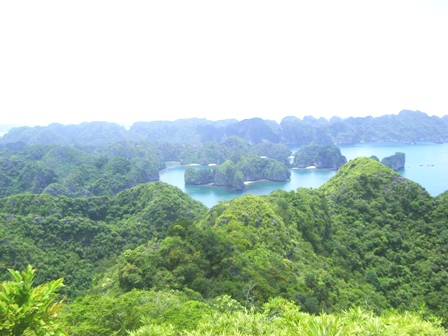Background
Cat Ba National Park is situated in Cat Hai District, Hai Phong City of northern Vietnam. The Park is located in a group of some 366 islands of the Cat Ba Archipelago - 45km east of Hai Phong City, 150km south - east of Ha Noi and borders with Ha long Bay to the north. The Park was established on the 31st March 1986 and now covers some 17,362.96 ha; approximately 10,912.51 ha are terrestrial ecosystems (islands), and 6,450.45 ha are marine ecosystems. It was the first ever national park to be established in Vietnam and is divided into three zones: strict protection; ecological recovery; and administrative services.
The key functions and tasks of the National Park include: conservation; scientific research; ecotourism & environmental education; and assistance to local community development
Geomorphology Value
The most striking feature in the geomorphology of Cat Ba National Park is fully developed karst scenery; previously developing on land but invaded by sea and continuing to change over time. Cat Ba Archipelago is a prime example of karst scenery with fenglin (cone karst) and fencong (tower karst) features which have been isolated and separated from one another by firths and valleys. The system of caves in the area is plentiful, diverse and complex, further research is required to better describe and understand the cave systems. Cat Ba has sufficient conditions to be listed as a Geo - Park. The combination of and numerous small islands gives the region a remarkably beautiful landscape with immense tourism potential.
Cultural and Historical value
Cat Ba is rich in historical and archaeological values. Initial research has confirmed that Cat Ba Island has been populated by humans for many thousands of years. There are relics that show important milestones in progress of ancient human societies. Cat Ba Island used to be an ideal settlement for man right from the time it was still part of the continent (around 9,000 - 17,000 years ago).
There are also a lot of special traditional festivals across Cat Ba.
Ecosystems
The Park differs from other national parks in Vietnam because of a great variety of ecosystems, landscapes and seascapes. It has many unique ecosystems such as the tropical rain forest on karst mountains, mangroves, coral reef, sea grass beds, caves, grottos, firths and valleys.
Fauna and Flora
Initially identified 1588 vascular plant species across 187 families, among these, 58 are species listed in the Vietnam Red Book (2007), the IUCN The World List of Threatened Trees (2008) has 33 species. 1,026 are medicinal plant species, with one newly recorded species: Cycas tropophylla.
According to the result of initial research, Cat Ba National Park has 338 terrestrial animal species including 53 species of mammal; 205 species of birds; 55 species of reptile and 25 amphibian species, among which 36 species listed rare and endemic in the Vietnam Red Book and the IUCN Red List. Most noticeable of which is Cat Ba Langur (Trachypithecus poliocephalus), a species endemic to Cat Ba and listed by IUCN as one of 25 world top most endangered primates
Marine Creature
Covering an area over 6,450 ha, the Park's sea possesses invaluable marine resources. According to scientific records, there are over 1,131 marine animal and plant species, including 196 species of sea fish, 193 species of corals, 538 species of zoo benthos, 75 species of sea grass, 199 species of phytoplankton, 89 species of zooplankton and 23 mangrove species.
Cat Ba is also famous for other sea specialties such as squid, lobster, crab, pearl shells, snout otter clam, blood ark . ect
 English
English  Tiếng Việt
Tiếng Việt Français
Français

